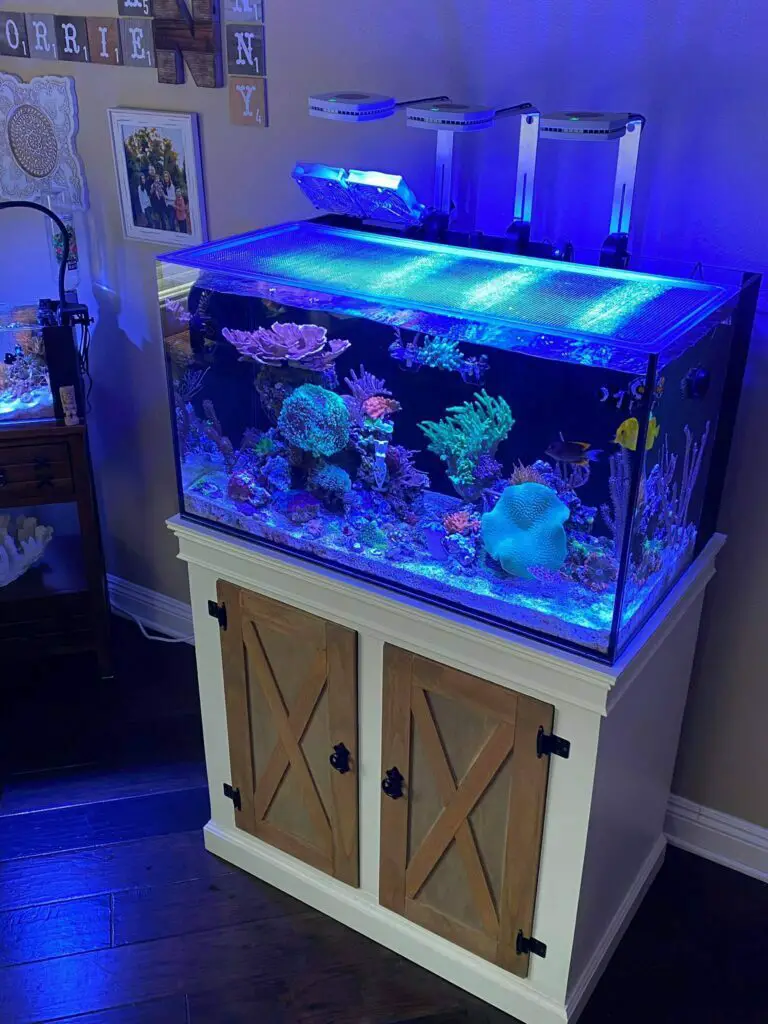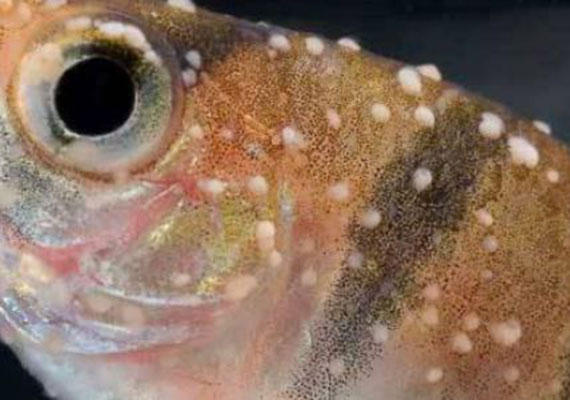How Much Oxygen Should Be in Fish Tank?
The amount of oxygen that should be present in a fish tank depends on the type and number of fish, as well as other factors such as water temperature, pH level, and filtration system. Generally speaking, a healthy environment for most fish requires an oxygen concentration between 6-8 parts per million (ppm). To maintain this level of oxygen in your tank you can use an air pump or bubbler to increase aeration.
You may also need to perform regular water changes to rid the tank of any excess waste which could decrease the amount of available oxygen. Additionally, adding plants to your aquarium can help keep levels up by providing natural photosynthesis. It’s important to regularly test your water quality with a dissolved oxygen meter so you know when it is time for a change or if more aeration is needed.
Just like humans, fish need oxygen to survive. That’s why it is important to keep your fish tank well-oxygenated by making sure the water in your tank contains enough dissolved oxygen for your aquatic friends. The amount of dissolved oxygen needed depends on the type and number of fish in the tank, but generally you should aim for a minimum level of 6 parts per million (ppm).
You can measure this with an aquarium test kit or ask a professional at your local pet store to help you out. With proper maintenance and frequent testing, you’ll be able to ensure that your fish have plenty of oxygen so they can live long and healthy lives!
Signs of Too Much Oxygen in a Fish Tank
One of the signs that your fish tank has too much oxygen is if you find a lot of air bubbles in the water. These air bubbles are caused by an overproduction of oxygen, and they may be seen on the surface or around plant leaves. Additionally, if your fish seem to be gasping for breath near the top, this could also indicate too much oxygen in the tank.
If left unattended, these conditions can become dangerous and even fatal for your fish.
How to Add Oxygen to Fish Tank Fast
Adding oxygen to your fish tank quickly can be achieved by either adding an air pump or an airstone. An air pump is a device that pumps in oxygen into the water and it can be connected to a timer so you know when it runs. An airstone is similar but instead of directly injecting oxygen, it creates tiny bubbles which dissolve into the water, increasing the amount of dissolved oxygen in your aquarium.
Both methods are effective for quickly replenishing oxygen levels in your tank; however, if you have larger tanks or multiple fish then an air pump might be more suitable as these tend to provide higher volumes of oxygen per minute than an airstone.
How to Put Oxygen in Fish Tank Without Pump
Adding oxygen to a fish tank without a pump is possible by creating an air stone. An air stone is a small device that breaks up the flow of water, which increases the level of oxygen in the water. This can be done easily and inexpensively with basic materials such as PVC pipe and aquarium tubing.
The key is to make sure you create enough bubbles for your fish tank so there’s adequate circulation of oxygen-rich water throughout the aquarium.
How to Test Oxygen Levels in Fish Tank
Testing the oxygen levels in a fish tank is an important part of maintaining a healthy aquatic environment. This can be done with an oxygen test kit, which contains testing strips that will turn a certain color to indicate how much dissolved oxygen is present in the water. To use these strips, simply dip them into your aquarium and wait for the results; if you’re looking for readings higher than 8 parts-per-million (ppm), then it’s time to add more aeration or make other adjustments to increase your fish tank’s oxygen levels.
How to Increase Oxygen in Fish Tank
One of the most important things to consider when keeping a healthy fish tank is how to increase oxygen in the water. The key to increasing oxygen levels in your aquarium is through regular water changes and proper aeration. Water changes are necessary for removing excess waste and toxins from your tank, while aerators help keep oxygen levels high by introducing a stream of bubbles into the water which helps stimulate movement on the surface, allowing fresh air to enter in more efficiently.
Additionally, live plants can be added as they produce oxygen during photosynthesis and provide shelter for fish.
How Much Oxygen Do Fish Need
Fish need oxygen in order to survive, and the amount they need depends on their species. Generally speaking, most fish require between 4-6 parts per million (ppm) of dissolved oxygen in the water for optimum health. Some more sensitive species may require oxygen levels as low as 2 ppm while some hardy species can even tolerate levels below 1 ppm.
To ensure that your aquarium is properly aerated and has enough oxygen for its inhabitants, it’s important to keep an eye on the readings with a good quality test kit or monitor.
Too Much Oxygen in Fish Tank
Having too much oxygen in your fish tank can be detrimental to the health of your fish. Oxygen is essential for respiration, but having an excess amount can cause a build-up of nitrates and ammonia which are toxic to aquatic life. This can lead to stress on the fish, ultimately leading to death if not addressed quickly.
Therefore, it’s important to monitor the oxygen levels in your tank regularly and make sure that they remain balanced.
Fish Tank Oxygen Tablets
Fish tank oxygen tablets are a great way to add dissolved oxygen into your aquarium. They help to keep the water clean and clear, promote healthy fish growth and reduce stress on fish. Oxygen tablets release oxygen slowly over an extended period of time, so they can be used in tanks of all sizes.
The amount of oxygen released depends on the size and type of tablet used, but it is typically enough for most aquariums.

Credit: www.youtube.com
How Do I Know If My Fish Tank Has Enough Oxygen?
Knowing if your fish tank has enough oxygen is an important part of keeping a healthy environment for the fish. It can be difficult to tell just by looking at the tank, but there are several ways that you can check to make sure there is enough oxygen in the water. The first thing you should do is make sure that you have adequate filtration and aeration in your tank; both help keep the water well-oxygenated.
You should also check for signs of stress or lethargy in your fish, which could be an indication of low oxygen levels. Finally, testing with a dissolved oxygen meter or strips will give you an exact reading so that you know exactly how much oxygen is present in your aquarium. With these steps taken, it’s easy to ensure that your fish tank always has enough oxygen!
Can There Be Too Much Oxygen in a Fish Tank?
Yes, there can be too much oxygen in a fish tank. When dissolved oxygen levels are too high, it can lead to an accumulation of toxic waste products and create an environment that is unhealthy for the fish living in it. Too much oxygen will also reduce the amount of carbon dioxide available for respiration, leading to stress and other health problems for your aquatic inhabitants.
The optimal dissolved oxygen level for a healthy aquarium should typically range between 6-8 parts per million (ppm). If you find that your aquarium’s O2 levels exceed 8 ppm, then you may need to consider adding more surface agitation or aeration via air stones and filters in order to bring the levels back down into a safe range. Additionally, regular water changes can help ensure proper dissolved oxygen balance by removing any excess toxins from the tank water.
How Long Should Oxygen Be on in Fish Tank?
When it comes to oxygen levels in fish tanks, the rule of thumb is that they should be kept on for at least 8 hours a day. This helps ensure proper oxygenation levels and keep your fish healthy. During this time, you should also make sure to check your tank’s water parameters regularly so you can monitor any changes in pH or ammonia levels.
If these ever reach unsafe ranges, then you may need to increase the amount of oxygen in the tank or perform more frequent water changes than usual. Additionally, if there are live plants in your aquarium, then supplementing with an air pump can help maintain adequate oxygenation as well as provide some beneficial circulation for the plants and other inhabitants of the tank.
What is the Best Oxygen Level Aquarium?
The best oxygen level for an aquarium varies depending on the types of fish you plan to keep. Generally, a good rule of thumb is to aim for an oxygen saturation level between 6-8ppm (parts per million). This range will provide adequate oxygen levels for most tropical fish and other aquatic species.
Additionally, it’s important to remember that dissolved oxygen levels can vary greatly from tank to tank, so it’s always a good idea to regularly test your water parameters in order to ensure optimal health and wellbeing of your finned friends! To further improve aeration in your aquarium, consider installing a filter with aeration capabilities or adding an air pump which will help increase the amount of dissolved oxygen in the water. Finally, be sure not to overpopulate your tank as this could lead to increased stress on fish due too little available space or insufficient amounts of dissolved oxygen being present.
Are Aquarium Air Pumps Oxygen Tanks? Fish Tank Bubbles, Do You Need Them?
Conclusion
In conclusion, the amount of oxygen in a fish tank is essential for maintaining healthy and vibrant aquatic life. Proper aeration should be monitored regularly to ensure that the oxygen levels remain within an acceptable range. There are various ways to control and maintain adequate amounts of dissolved oxygen in aquariums such as water changes, adding air stones or powerheads, and increasing surface agitation.
With proper care and maintenance, you can keep your fish safe and happy by providing them with the right amount of oxygen in their environment.






